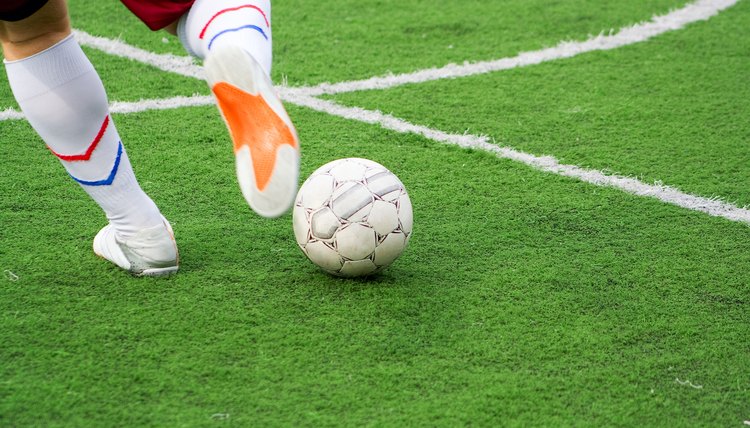5 Types of Soccer Passes

Soccer is a fast-paced game requiring speed, good footwork skills and accurate passing. The kind of pass you choose to execute depends on the defense and positioning of your opponents. Some passes are used to create a strong offensive drive and scoring opportunities, while defensive passes are used to slow down the game or maintain possession of the ball when under pressure. A good soccer player has the ability to kick several types of passes.
Push Pass
Sometimes referred to as a direct pass, this is probably one of the most-used passes in soccer. It tends to be a safe pass and is typically executed when you're near teammates. The best technique for the push pass is to first plant your nonkicking foot alongside the ball and point it in the direction you want the ball to go. When you contact the ball, use the inside of your kicking foot. You want to hit the middle of the ball with your kicking heel down and the toe pointing up.
Long Pass
The long pass is used to clear the ball to the opposite side of the field to a teammate who is open and has no defenders around her. This changes the area of play and gives your team the opportunity to begin a counterattack. Executing a long pass involves hitting the ball with accuracy and power. A good technique to use is to lock the ankle of your kicking foot, hit the middle of the ball with the laces of your cleats and follow through toward your teammate with your kicking leg.
Backward Pass
This is a defensive pass and is used when defending players have closed off all forward passing possibilities. It is also used when defenders put pressure on the offensive ball carrier, hoping to steal the ball or cause a passing error. The backward pass is a way to neutralize the pressure and still maintain control of the ball. The ball is passed backward with the heel or sole of your foot to another teammate.
Piercing Pass
The piercing pass is also referred to as a tunnel pass or a through pass. The opportunity to use a piercing pass does not happen often when playing against a good defense because the defenders typically position themselves to avoid an open space, or tunnel, from the ball carrier to her attacking teammate. This pass requires good timing between teammates because the receiving teammate must not be in an offside position when the ball is passed. This is where the receiving player is closer to the goal than the last defender. When the opportunity does arise, the attacker quickly passes the ball, penetrating the defenders. This creates a scoring potential.
Wall Pass
This is a combination pass involving two teammates and is sometimes referred to as a one-two pass. This type of pass involves a wing player and an inside teammate. The wing player's position usually runs along the outside of the field. When the wall pass is executed properly, the wing player passes the ball from the outside of the field to a teammate playing a position toward the inner part of the field. This player acts as a wall and quickly passes the ball back in front of the wing player. Wall passes are most effective against slower defenses.
